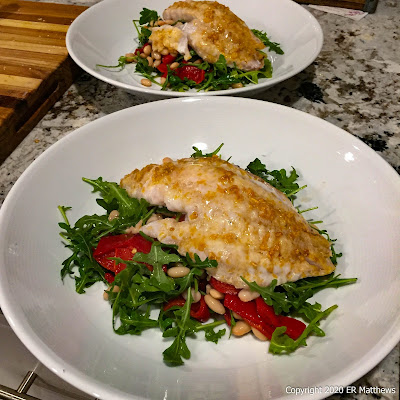I'm pretty new to the whole Valentine's Day thing. When I was in the restaurant business, it was easily our busiest time of the year. Imagine doing a month's worth of business in a one- or two-day stretch, each table being sat twice a night and served seven courses! It took a week before Valentine's Day to prep for the special menu and it took a week after to recuperate. Besides never being home for Valentine's Day, I was also a zombie. It is still a wonder to me that Ann stuck by me through all that.
This year, I wanted to do something special to surprise her. Because of COVID, going out is not an option. But realistically, because I was in the business and know how stressed restaurants are under the crush of business, I would never go out for Valentine's dinner anyway. Still, I cook dinner every night and so cooking dinner would not really be special. I opted instead to make a special brunch.
 |
| Raspberry, Chocolate, Blood Orange Bread Pudding |
What was different is that for brunch I made something totally out of left field. We don't eat sweets, fruit aside, and our diet is very low in simple carbs. So naturally, I made a Raspberry, Chocolate, Blood Orange Bread Pudding because that would be the absolute last thing that she would expect from me. And I made it under Ann's nose. She didn't know anything about it until about 45 minutes into its baking when it started to perfume the house. I served it with blood orange segments on top to help cut the sweetness.
 |
| A Jam Bread Pudding |
This bread pudding was inspired by my mother's mother. When I would visit my grandmother during college breaks, she would sometimes smear slices of white bread with butter and jam and shingle them in the bottom of a pan. She would then pour a custard over the bread and a few minutes later, a bread pudding would emerge from her oven.
The
challah-based savory bread pudding that I made for New Year's Brunch cemented for me that soft breads such as the store-bought white loaf bread that my grandmother used do not make great bread puddings. A good bread pudding needs a hearty bread with a good crust. A lot of the charm of a great bread pudding is the contrast of the soft interior with a crunchy crust, something you do not get from indifferent bread.
I bought a good quality focaccia for this bread pudding. I used focaccia because it is the depth of my pan and so I could expose the focaccia crust through the top of the pudding. Assembling the bread pudding on the QT was something of a challenge. Each time Ann would leave the room, I would do a bit more: slicing the bread, spreading raspberry jam on each slice, chopping a block of chocolate, making the orange-vanilla custard base, putting all the ingredients together, and "hiding" the pudding in plain sight in the back of the refrigerator.
I made a quart of custard base: a quart of 2% milk, a splash of vanilla extract, the zest of one blood orange, five eggs, and a scant half a cup of sugar. Initially, the pudding took about half the custard, the remainder of which I put in the refrigerator and used to top off the pudding before I went to bed the night before. In all, the pudding took about 3-1/2 cups of custard base.
Valentine's morning while Ann was brushing her teeth, I put the pudding in the oven. She had no idea what was going on until it was just about done and started making the house smell great.
 |
| Mimosa, Crossword, and Ed-Made Valentine's Day Card |
It's our morning ritual to have our coffee along with a crossword puzzle from the Sunday New York Times. I left a Valentine's card on the table where we do our crosswords. I always make Ann a card (having never felt that buying a card from the store expresses anything about me except that I was lazy) and this year was no different.
When Ann was upstairs printing the crossword puzzle, I brought in the bird condo that you see in the photo below as another surprise for her. She had expressed interest in having one (along with explicit instructions: "the center has to be red") some weeks ago and I demurred, having already a very long list of woodworking projects on my list.
As I was working on those other projects, I took time and converted scrap lumber to the bird condo for her. It now adorns our back gate.
 |
| Bird Condo Above Our Back Gate |
Once the bread pudding came out of the oven, I made us some mimosas and we sat down to splurge for Valentine's brunch. As good as this bread pudding was, I'd rather have had a savory bread pudding. Note to self.

































